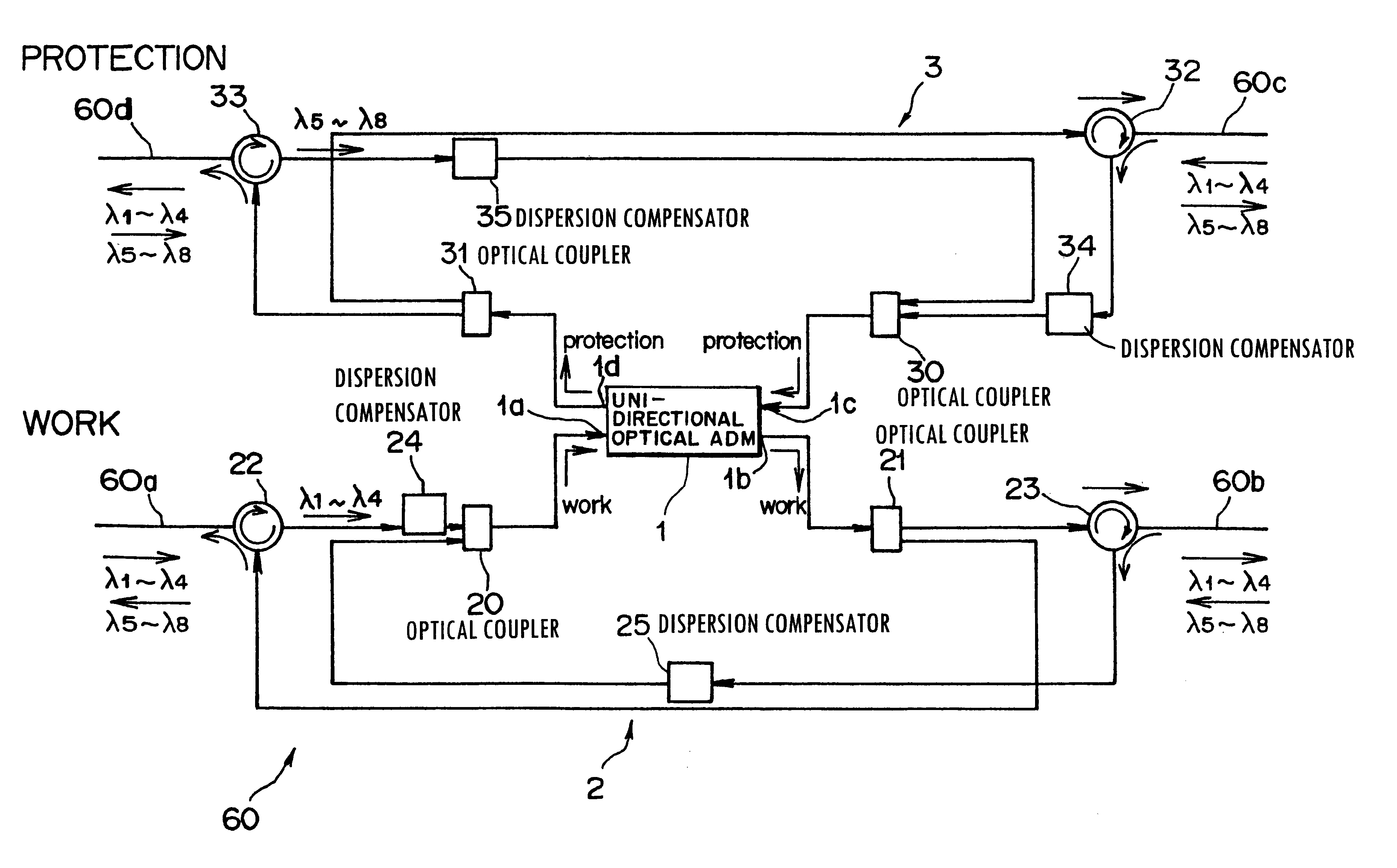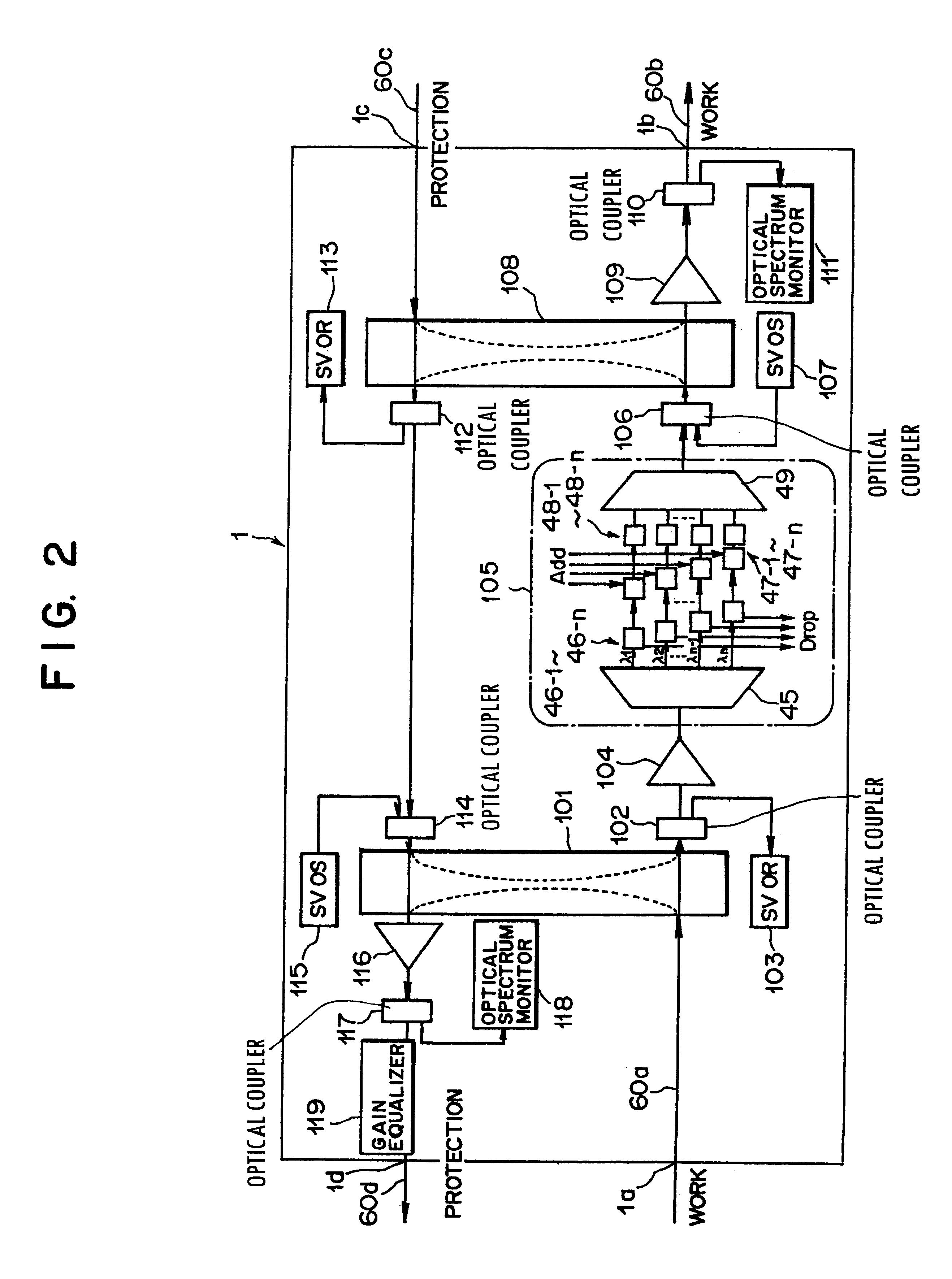Optical transmission device for bi-directional optical communication
a transmission device and optical communication technology, applied in the field of optical transmission devices for bi-directional optical communication, can solve the problems of inability to perform normal communications between optical transmission devices, inability to perform branching/insertion of optical signals transmitted from the reverse direction, and reduced throughpu
- Summary
- Abstract
- Description
- Claims
- Application Information
AI Technical Summary
Benefits of technology
Problems solved by technology
Method used
Image
Examples
first embodiment
the present invention will now be described with reference to the accompanying drawings.
Referring to FIG. 1 which is a block diagram, there is shown a constitution of an optical transmission device used for bi-directional optical communications according to the first embodiment of the present invention. A bi-directional optical communication optical transmission device 60 shown in FIG. 1 is positioned between optical fibers (bi-directional communication optical transmission lines) 60a and 60b for performing bi-directional optical communications by transmitting optical signals having wavelengths different between clockwise and counterclockwise directions. The optical transmission device 60 performs specified optical transmission processing for the optical signals transmitted through these optical fibers 60a and 60b. The optical transmission device 60 comprises an optical ADM device 1 and a first direction changing unit 2.
The optical ADM device (uni-directional optical ADM, uni-direct...
first modified example
(b) First Modified Example of the First Embodiment
According to the foregoing bi-directional communication optical transmission device 60 of the first embodiment, in the first direction changing unit 2, optical signals (first and second optical signals) transmitted in two ways are branched by using the optical circulators 22 and 23. However, instead of the optical circulators 22 and 23, optical couplers may be used for the same purpose. For example, in the case of a bi-directional communication optical transmission device 61 shown in FIG. 9, in a first direction changing unit 2A, optical signals are branched by using optical couplers 26 and 27. These optical couplers 26 and 27 are respectively constructed as wavelength-division multiplexing / demultiplexing type couplers.
Specifically, the optical coupler 26 branches the first optical signals from the optical fiber 60a through the distribution compensator 24 to the optical coupler 20 and the second optical signals demultiplexed by the o...
second modified example
(c) Second Modified Example of the First Embodiment
Referring to FIG. 10 which is a block diagram, there is shown a second modified example of the bi-directional communication optical transmission device of the first embodiment.
In the foregoing bi-directional communication optical transmission devices 60 and 61, the bi-directional flows of the optical signals are unified in a single direct-on by using the 1.times.2 WDM optical couplers 20 and 21 (optical couplers 30 and 31 in an emergency). However, in the second modified example, as shown in FIG. 10, a bi-directional communication optical transmission device 62 is constructed by using a 2.times.2 WDM optical coupler 28 (2.times.2WDM optical coupler 38 in an emergency).
Specifically, the bi-directional communication optical transmission device 62 shown in FIG. 10 is positioned between normal-time optical fibers 60a' and 60b' and between emergency optical fibers 60c' and 60d', and performs specified optical transmission processing for ...
PUM
 Login to View More
Login to View More Abstract
Description
Claims
Application Information
 Login to View More
Login to View More - R&D
- Intellectual Property
- Life Sciences
- Materials
- Tech Scout
- Unparalleled Data Quality
- Higher Quality Content
- 60% Fewer Hallucinations
Browse by: Latest US Patents, China's latest patents, Technical Efficacy Thesaurus, Application Domain, Technology Topic, Popular Technical Reports.
© 2025 PatSnap. All rights reserved.Legal|Privacy policy|Modern Slavery Act Transparency Statement|Sitemap|About US| Contact US: help@patsnap.com



